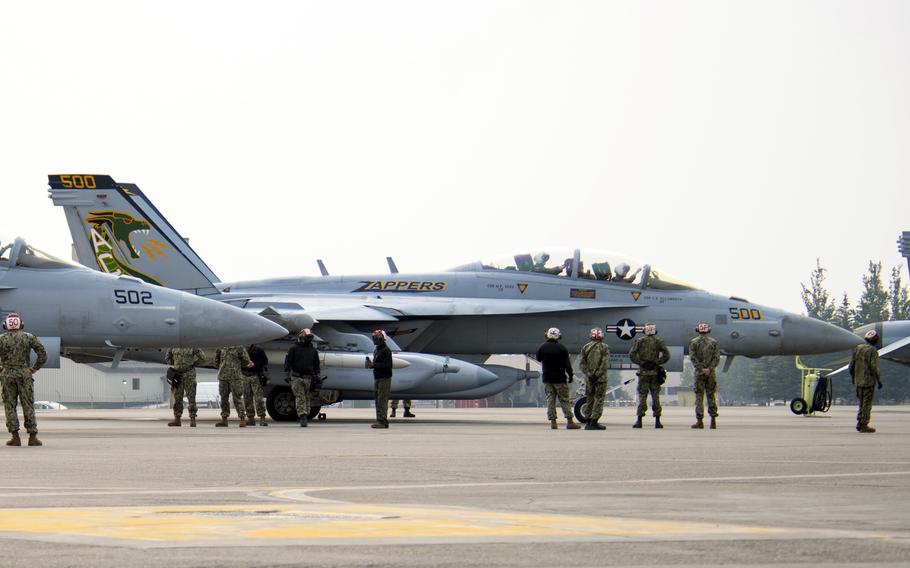
A U.S. Navy EA-18G Growler assigned to Electronic Attack Squadron 130 takes part in Red Flag drills in Alaska in 2022. (Ryan Lackey/U.S. Air Force)
TACOMA, Wash. — The Navy has not found the wreckage or crew of an EA-18G Growler jet that crashed on the east side of Mount Rainier, service officials said Wednesday.
“We think we are close,” said Cmdr. Beth Teach, a public affairs officer for Naval Air Force Pacific in San Diego.
The jet from Electronic Attack Squadron 130 at Naval Air Station Whidbey Island, Wash., crashed at about 3:23 p.m. Tuesday, service officials said. The air station is about 100 miles northwest of Mount Rainier. Searchers are now concentrating on a rugged area about 30 miles west of Yakima, Wash.
The Navy has not identified the pilot and electronic weapons officer who were flying the missing jet. A MH-60S Sea Hawk search and rescue helicopter was used overnight to look for signs of the crash near the 14,411-foot peak of the mountain.
Navy surveillance aircraft based at Whidbey Island, including P-3 Orion and P-8A Poseidon planes, have crisscrossed the mountainside using sensors and radar to hunt for possible debris and survivors.
“Responders are facing mountainous terrain, cloudy weather, and low visibility as the search is ongoing,” Teach said.
The Army’s 7th Infantry Division has also sent UH-60 Black Hawks and OH-58 Kiowa Warrior helicopters from Joint Base Lewis-McChord — about 35 miles from Mount Rainier — to join the search at the Navy’s request.
Teach said the Navy is also coordinating with Yakima tribal authorities and law enforcement agencies in the possible crash area to assist in the search.
Teach said she did not know whether the pilots had been able to eject prior to the crash. She also did not know whether the pilots were flying through VR 1355 — a military training route nicknamed “The Million Dollar Run” through the mountainous area popular with Growler pilots for its challenging terrain. Several videos of Growler pilots going through the turns, climbs and dives have been posted to YouTube.
“The Million Dollar Run” draws civilian plane-spotters looking to see military aircraft flying at high speed and low levels, and alerts of planes flying the route are shared on social media, especially Reddit.
The twin-engine Growler is a variation on the F/A-18F Super Hornet jet and was assigned to Electronic Attack Squadron 130 — nicknamed “Zappers.” Growlers have been used by the Navy since 2009.
The role of the Growler is to attack enemy radar and missile targets ahead of American fighter aircraft. With 11 weapon points for missiles, bombs, and electronics, the Growler can attack enemy command and control centers, according to the Navy website on the aircraft.
The Growler has a digital radar warning receiver, which provides 360-degree readings to identify threats, and an integrated jamming system that allows the jet to attack radar installations attempting to track incoming aircraft.
Daylight has allowed for a greater view in the search area, Teach said. However, winter-like weather at higher elevations and rain throughout the southern Puget Sound area made flight conditions more difficult.
The National Weather Service reported rain and snow Tuesday evening near the peak of Mount Rainier. Factoring in wind chill, overnight temperatures were forecast to dip below freezing on the mountain. More snowfall was expected Wednesday, with rain and snow throughout the weekend.
The Electronic Attack Squadron 130 had deployed as part of the USS Dwight D. Eisenhower strike group, which returned in July to Norfolk Naval Station, Va. The strike group spent nine months in the Middle East, guarding military and commercial vessels and fending off Houthi missile and drone attacks in the Red Sea and Gulf of Aden. Carrier Air Wing 3, based at Naval Air Station Oceana, Va., embarked on the Eisenhower with nine squadrons and detachments.
All EA-18G Growler squadrons are stationed at NAS Whidbey Island, northwest of Seattle on Puget Sound, the Navy said. The exception is Electronic Attack Squadron 141, attached to Carrier Air Wing 5, based at Marine Corps Air Station Iwakuni, Japan.
The Growler was developed to replace the EA-6B Prowler aircraft, which entered service in 1971 and retired in March 2019.